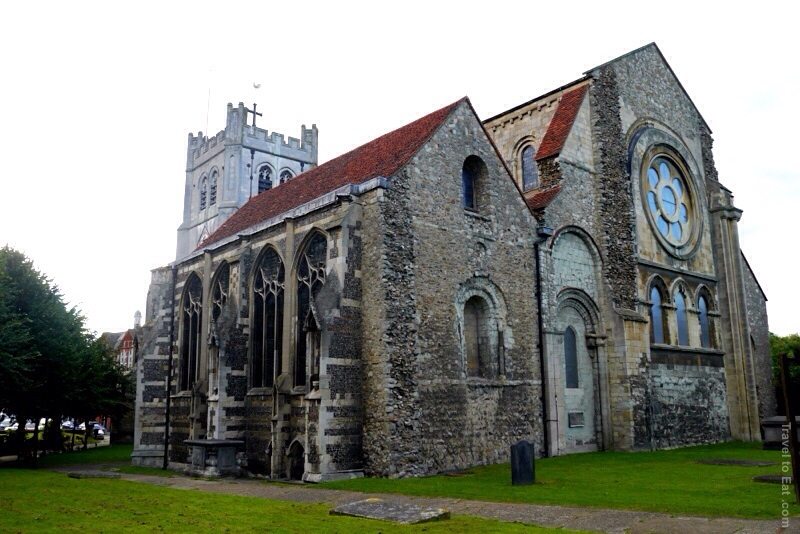

The name Waltham derives from weald or wald “forest” and ham “homestead” or “enclosure”. The name of the ancient parish as a whole is Waltham Holy Cross, but the use of the name Waltham Abbey for the town seems to have originated in the 16th century. Waltham Abbey is one of those towns whose history is interwoven with that of its most important building, the Abbey itself. The riverside site of the town together with the well drained gravel terrain attracted early settlers. There are traces of prehistoric and Roman settlement in the town. Ermine Street lies only 5 km west and the causeway across the River Lea from Waltham Cross in Hertfordshire may be a Roman construction. Radiocarbon dating places a church and one grave from the 7th century.

The recorded history of the town began during the reign of Cnute in the early 11th century when his standard-bearer Tovi or Tofig the Proud, rebuilt a church here to house the miraculous cross discovered at Montacute in Somerset. A black flint cross (the “Holy Rood”) was said to have been discovered atop a hill in Montacute earlier in the eleventh century by the village blacksmith. This was supposedly placed in a wagon by Tofig, and he named a series of possible destinations owned by him. The oxen pulling the wagon (six red and six white in one version of the tale) refused to move until he said “Waltham”. Hence the Parish name, Waltham Holy Cross.


This relic had become an object of veneration, pilgrimage and celebration. “Holy Cross” was the battle-cry of Harold's armies at the battles of Stamford Bridge and Hastings. The Holy Rood is said to have foretold Harold's defeat at Hastings: on the way there from the Battle of Stamford Bridge he stopped off at Waltham Abbey to pray, and the legend is that the cross “bowed down” off the wall as he did so. This was taken as a portent of doom. The cross was lost in the dissolution of King Henery VIII. The Bayeux tapestry above shows his death. A figure in the panel of the Bayeux Tapestry with the inscription “Harold Rex Interfectus Est” (Harold the King is killed) is depicted gripping an arrow that has struck his eye, but some historians have questioned whether this man is intended to be Harold, or if Harold is intended as the next figure lying to the right almost prone, being mutilated beneath a horse's hooves or perhaps both. You can review the history of this time on my post on Normandy.

William the Conquerer refused Harold's mother his body but it was later identified by his mistress Edith Swan-neck and brought to Waltham for burial. He was buried behind the alter but when the abbey was destroyed by Henry VIII, it ended up outside, behind the church. As Earl of Essex, before he was king, Harold Goodwin had extended the church. The church was again rebuilt by the Normans between 1090 and 1150 in a romanesque style.


In 1184 King Henry II established an Abby at the church and extended it three times it's present length. It became one of the largest and most important religious houses in the country. When Henry VIII dismantled the church, he destroyed all of Henry II's extensions, leaving only the nave as the present church. You can see in the above picture of the rear of the church how it seems to have been chopped off. The “herringbone” pattern of the stones on the left side of the building, seen in more detail to the right can be attributed to King Harold's original extensions. Harold's grave is seen in the lower left corner in the picture above.



Where the cloister used to stand is now a large park seen in the top picture. You can see an arched doorway at the end. The second picture is where the church stood. All of these walls were constructed using the rubble of the old abbey. If you look at a closeup picture of the wall as seen to the left, you can see little round stones. These are the remains of the ends of pillars of the walkway of the cloister. They were cut into wall thickness lengths and used to build the wall. When they ran out of rubble from the church, they finished the wall in brick as seen at the top.

The abbey had a large library which is now largely gone. The Waltham Abbey Bible shown above is in the collection of the Epping Forest District Museum in Waltham Abbey. The Bible that dates to about 1200 AD is all that survives from the Abbey library, which contained biblical, medicinal, philosophical and legal texts as well a Latin translation of Homer's Iliad. Listed in the bible are 128 other books. The bible is written on vellum (parchment), the standard writing material in medieval England, this was made from treated animal skins. The holes in the vellum were made when the skin was being treated, but the material was so expensive that the scribe, copying the text, used it anyway.

